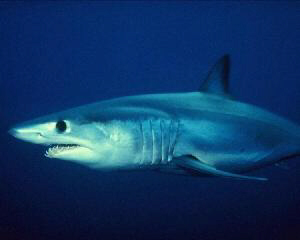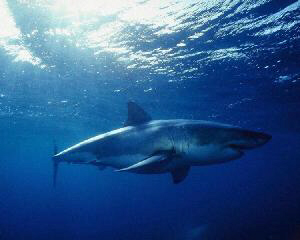|
DORSAL FINS:
Sharks dorsal fins, as it suggests the term, are situated on the back of
the animal and generally are two, with form and different dimensions
according to the habits of life of the single kinds. In the sharks that
live to narrow contact with the fund, the fins are behind, while in
those more active, the pelagic sharks, the fins are generally found in
more advanced position. They can have triangular form, rounded off,
trapezoidal and very various dimensions, with the first dorsal almost
more great of the second. In a lot of kinds their aspect can have an
important systematic value for the recognition of the order and the
shark family. The dorsal fins are sustained by an inside cartilaginous
skeleton. It is constituted by basal cartilages, nearer to the vertebral
column and radial cartilages, connected to fibrosis rays that has to
sustain the portion more expanded of the fin. In this way the fins
acquire sturdiness and elasticity, essential characteristics for a
correct movement and equilibrium of the shark.
The dorsal fins, together
with those anal, develop the function to facilitate the maintenance of
the rout and to avoid the oscillation of the shark along his own axle.
The sighting of a fin that emerges from the surface of the water is not
always tied to the presence of a shark, there are other animals as the
dolphins, the sword fishes and also the mantas, that are usual to
present themselves in surface in this way. Then the dangerous dorsal fin
that sprouts from the water, often in partnership to great predatory
sharks and source of scary histories, can reality hide the presence of a
more reassuring and beloved dolphin.
CAUDAL FIN:
The caudal fin constitutes the principal element in the shark movement:
it is in fact the move to the right and left to provoke the animal
advancement. In a lot of kinds it is clearly asymmetrical and such
irregularity of aspect is to connect to the vertebral column of the
sharks that, in the final part, folds up upward and it becomes a support
for the superior lobe of the fin. Generally this is more developed and
the terminal part has a triangular form. The inferior lobe can have
different degrees of development assuming an important role to determine
the general aspect of the tail. The inferior lobe can be small, almost
absent, as in the zebra shark and nurse shark, to allow movements in a
little distance from the fund, or very developed, reaching her same
dimensions of the superior lobe and making the tail assume a half-moon
form, as in the white shark. If a shark is observed from behind during
the swimming the difference of push can be noticed from the two lobes,
due to their different conformation. The superior lobe develops a
greater power that pushes the shark in but also downward. The situation
is balanced however by the movement of the inferior lobe, that allows to
unload big part of the propulsive energy in the center of gravity of the
animal.
The shark movement can have two different styles: the first like
a eel and the second more powerful. In the first style the caudal fin
and the whole rest of the body stir to the right and left, in rather
slow and constant way, while in the second it is only the tail to move
and the shark is characterized by a more nervous movement. These fishes
generally pass from a style to the other during their growth: like a eel
from small and more powerful when they are exemplary adults. The caudal
fin has an important systematic value for the orders and families
recognition, changing in relationship to the different shark life habits.
CLASPER AND PELVIC FINS:
In the male sharks the terminal part of the pelvic
fins, (equal fins that have the function to stabilize the rout of the
animal) become longer and it calcifies more and more to form the
claspers (two), the sexual organs through which the shark reproduces
himself. The reproduction is internal and appen with the introduction of
a clasper (the other one is a backup) in the cloaca of the female shark.
This is a very bloody moment, in fact the male repeatedly bites the
female on the fins and on the back to stimulate her/ and to hold her
firm.
Around the 30% of the sharks has a oviparous reproduction, that is when
the female deposes outside the eggs; around 50% has a aplacental
viviparous reproduction, that is when the female produces the eggs that
open inside her body and the small sharks go outside completely formed;
the remained 20% has a placental viviparous reproduction, that is when
the embryo is in contact with her mother through a primitive placenta.
PECTORAL FINS:
Also the pectoral fins, as all the others, have form and different
dimensions in base to the sharks habits, generally ampler and lengthen
in the bentonic sharks, that live next to the fund, smaller instead in
the great raiders that live in open sea. (smaller in proportion to the
rest of the body)
The pectoral fins have the same functions of the wings of an airplane
opposing downward the push due to the propulsion of the caudal fin.
ANAL FIN:
The anal fin, together with the dorsal ones, allows the shark to
maintain the more possible the navigation rout and to avoid excessive
oscillations along his longitudinal axle.


|
|

